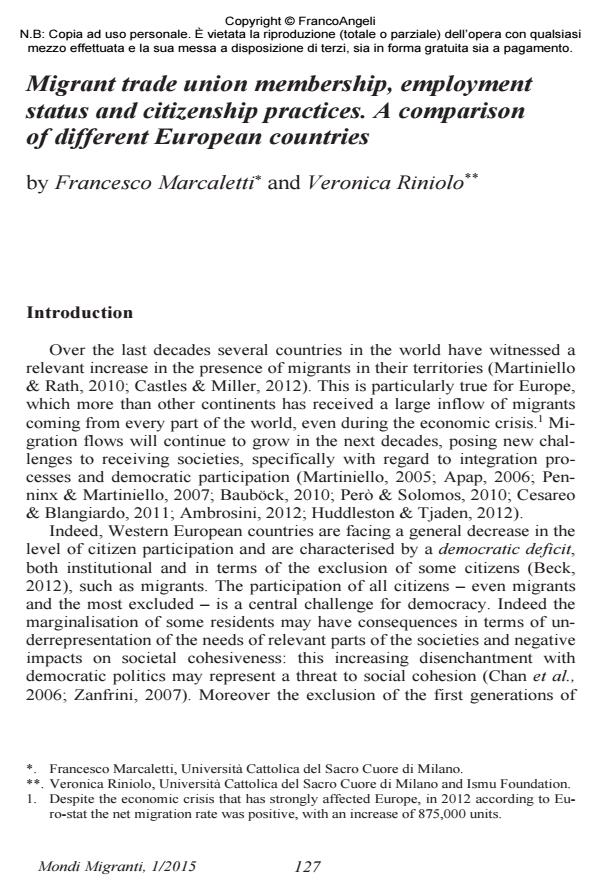Migrant trade union membership, employment status and citizenship practices. A comparison of different European countries
Titolo Rivista MONDI MIGRANTI
Autori/Curatori Francesco Marcaletti, Veronica Riniolo
Anno di pubblicazione 2015 Fascicolo 2015/1
Lingua Inglese Numero pagine 23 P. 127-149 Dimensione file 92 KB
DOI 10.3280/MM2015-001007
Il DOI è il codice a barre della proprietà intellettuale: per saperne di più
clicca qui
Qui sotto puoi vedere in anteprima la prima pagina di questo articolo.
Se questo articolo ti interessa, lo puoi acquistare (e scaricare in formato pdf) seguendo le facili indicazioni per acquistare il download credit. Acquista Download Credits per scaricare questo Articolo in formato PDF

FrancoAngeli è membro della Publishers International Linking Association, Inc (PILA)associazione indipendente e non profit per facilitare (attraverso i servizi tecnologici implementati da CrossRef.org) l’accesso degli studiosi ai contenuti digitali nelle pubblicazioni professionali e scientifiche
The present paper investigates migrant trade union membership in three different European areas, i.e. Western and Nordic countries, Southern countries and Central-Eastern countries, drawing on data from the European Social Survey 2012 Round 6, ed. 2.0. Specifically, the objectives are twofold: first, to compare trade union membership between natives and migrants in the three European areas analysed; second, to investigate the extent to which the possibility of being a member of a trade union is affected by other factors, notably individual characteristics (age, migration background, gender); employment status (economic activity, type of contract) and citizenship practices. The descriptive analysis shows that migrant patterns of unionization vary greatly in the three areas considered. Moreover the multivariate analysis (logistic regression) highlights that some factors are strong prediction variables of trade union membership, specifically the migration background, gender, age, educational attainment, employment status, country area, and some citizenship practices.
Il presente lavoro indaga l’appartenenza sindacale dei migranti in tre diverse aree europee, vale a dire i paesi occidentali e nordici, i paesi del Sud e paesi dell'Europa centrale-orientale, attingendo dati dell'Indagine sociale europea 2012 Round 6, ed. 2.0. In particolare, gli obiettivi sono duplici: in primo luogo, confrontare l'appartenenza sindacale tra nativi e migranti nelle tre aree europee analizzate. E, in secondo luogo, verificare se la possibilità di far parte di un sindacato è influenzata da altri fattori, come le caratteristiche individuali (età, background di migrazione, di genere); lo status occupazionale (attività economica, tipo di contratto) e le pratiche di cittadinanza. L'analisi descrittiva mostra che i modelli di sindacalizzazione dei migranti variano notevolmente nelle tre aree considerate. Inoltre l'analisi multivariata (regressione logistica) sottolinea che alcuni fattori sono forti variabili di previsione di appartenenza sindacale, in particolare il contesto migratorio, il genere, l’età, il livello di istruzione, lo stato di occupazione, la provenienza rutale e alcune pratiche di cittadinanza.
Parole chiave:Appartenenza sindacale, contesto migratorio, European Social Survey Round 6, stato di occupazione, pratiche di cittadinanza
- Do Migrants Get Involved in Politics? Levels, Forms and Drivers of Migrant Political Participation in Italy Livia Elisa Ortensi, Veronica Riniolo, in Journal of International Migration and Integration /2020 pp.133
DOI: 10.1007/s12134-019-00703-x
Francesco Marcaletti, Veronica Riniolo, Migrant trade union membership, employment status and citizenship practices. A comparison of different European countries in "MONDI MIGRANTI" 1/2015, pp 127-149, DOI: 10.3280/MM2015-001007